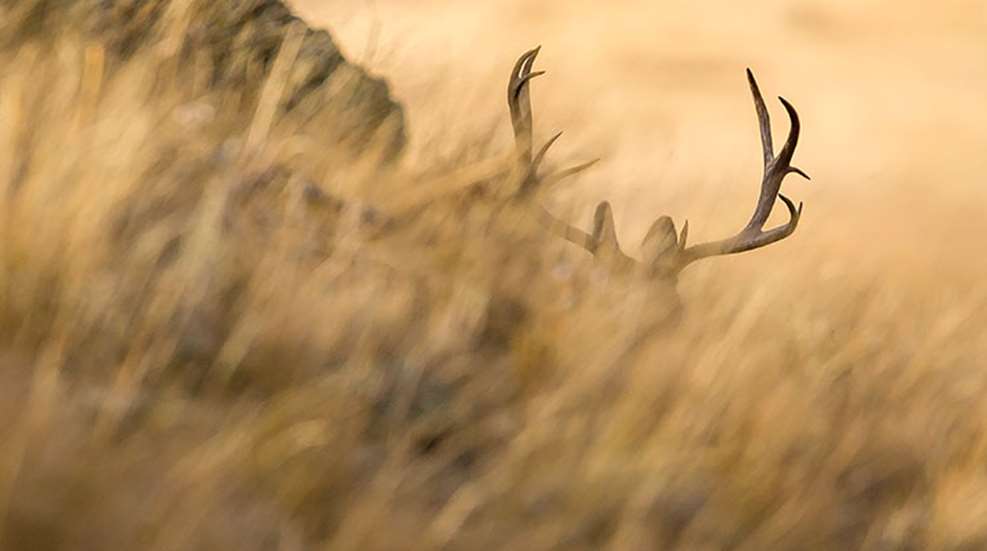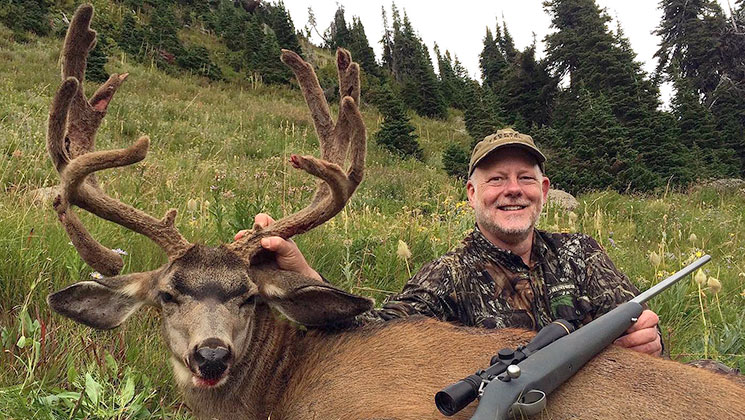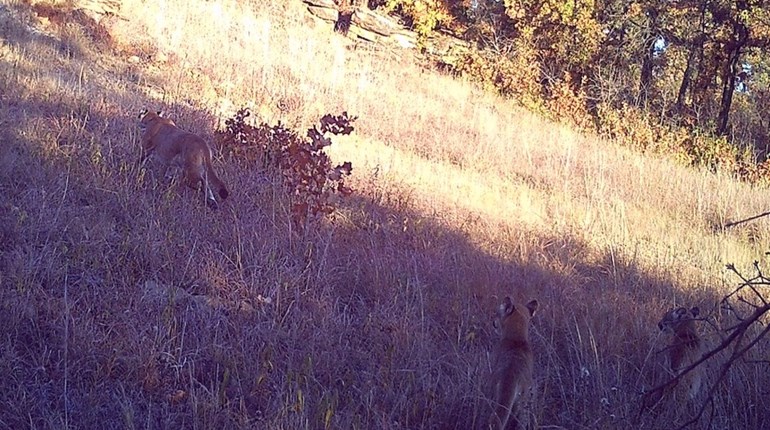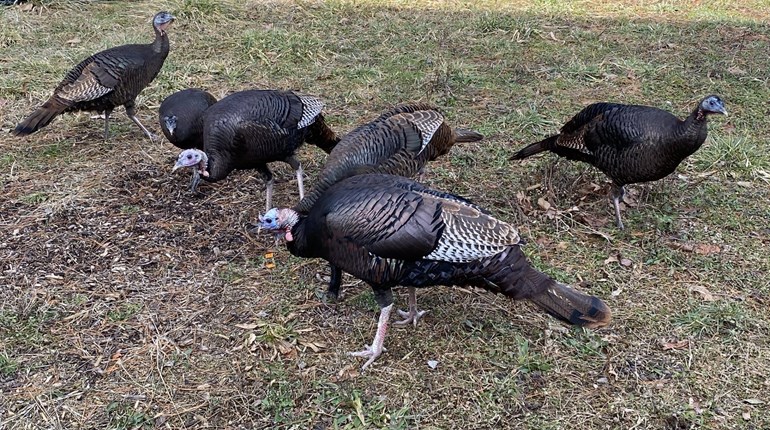
For many years, I’ve heard and read that a mule deer is the most difficult species to place in the Boone and Crockett Club’s records book. On occasion, I’ve said it myself. It certainly seems logical, given the swarms of mule deer hunters taking to the mountains and canyons each fall compared to the number of really big bucks that get a tag tied to their antlers. It is safe to say that those making this declaration, myself included, were stating an opinion rather than deliberately fibbing, just as certainly as there is much more to mule deer hunting than chasing a score. In an effort to sort out where things stand today, I visited with some folks who know quite a bit about the current state of mule deer hunting—trophy and otherwise.
Keith Balfourd is the director of marketing and an official measurer for the Boone and Crockett Club. Something over 125 years old, this grandpappy of all conservation organizations is most appropriately based in Montana. When asked if mule deer were indeed the toughest species to put into the book, Keith stopped just shy of confirmation.
“An all-time records book typical mule deer is one of the most elusive categories in Boone and Crockett records for two primary reasons,” Keith responded. “By the time most bucks reach the age where they have a chance at 190 inches of net score, it is common for abnormal points to appear. Consequently, a good number of bucks manage a qualifying gross score, yet net out due to lack of symmetry. Secondly, mule deer populations have been in decline across most of their range for a variety of reasons. Fewer mule deer reduces the harvest and with it the number of potential entries.”
In 1993, due to a continuing drop in the number of entries—one of the data points the Boone and Crockett Club uses to track overall species vitality—the all-time records book minimum score for typical mule deer was lowered from 195 to 190. The nontypical category benchmark was reduced by an even larger margin, from 240 to 230. Why double the reduction? “Nontypicals are rare by nature,” Keith explained. “In order to tape 230, a buck has to be a pure nontypical, meaning its antlers must be something more than just a big typical frame with a few stickers.”
“It is interesting to note,” Keith added, “that in the early days of records keeping, nontypical mule deer entries far outpaced those in the typical category. This continued until about 1960, when typical entries became more common. They’ve held the lead ever since. I suspect the reason is that prior to Boone and Crockett Club records becoming well known, the more strange and unusual antlers where prized and, therefore, likely to be retained.”
That the Boone and Crockett Club calls Missoula home is fortuitous for Keith. An avid hunter, he carefully researched Montana’s mule deer opportunities and began applying for a special permit in a nearby hunting district. Forest fires had blown through the area during the summer of 2000, creating an ideal mosaic of rejuvenating habitat. The mule deer population grew rapidly and fantastic bucks began to appear. In 2005, permits in the unit were increased from 25 to 150, and one of them showed up in Keith’s mailbox. After months of scouting, and 32 days of scouting and hunting, he spotted a spectacular buck, made a perfect stalk and took the deer with a single shot. With a gross score of 211 6/8 and a net of 203 5/8, Keith’s mule deer stands as the largest typical ever taken in Montana by a hunter.
Along with everyone else in my family, my daughter, Keni, has applied for this same hunting district for the last 14 years. In 2014, she beat the 100-to-1 odds and pulled a permit. Upon hearing the good news, we set about learning the area. Keith volunteered to show us around, so Keni, her husband-to-be, Dustin, and I drove down from Kalispell and spent an August weekend in the mountains with him, mapping spots and marking prime access that would allow her to hunt from the road.
Keni was nursing a shattered ankle when the season started yet remained determined to hunt on foot. Waiting until the rut began and with Dustin packing her rifle much of the time, she shuffled several miles into one of Keith’s recommended areas and picked a likely overlook for lunch. While they were eating she located a bedded doe, then Dustin glassed up a dandy buck in the nearby trees. Through her binocular the buck looked good and through her scope he looked even better. The shot was just 160 yards, not much of a stretch for Keni’s .26 Nosler. It was nearly midnight before they had her great 4x4 loaded in the pickup.
Big mule deer can turn up anywhere in Montana. I found one long ago on the eastern plains and a friend took one south of Glacier Park. Recently, a neighbor lady shot a tremendous nontypical right behind her house. Every winter, or so it seems, outfitter and hunting consultant Keith Atcheson teases me with photos of the trophy deer taken by his hunters on his long-time lease in a central mountain range.
Idaho is another state that offers great mule deer hunting. Tags are relatively easy to come by for nonresidents and opportunities vary from wilderness horseback adventures to spot-and-stalk on easily accessible public land. Bruce Duncan of Selkirk Guiding and Outfitting operates a fantastic guiding operation in the northern part of the Panhandle. I’ve known Bruce for a very long time and we’ve shared some memorable hunts for cougar, bobcat and black bear. Several years ago, Bruce told me about a single deer permit he was awarded each season. Good for either mule deer or whitetail, the permit hunt dates spanned more than three months with an opening day in late August. It took a moment for it to sink in that this was an opportunity to rifle hunt for velvet mule deer bucks in their high summer range. Problem was, another client had first right of refusal and he always bought it.
Bruce phoned last August. “If you still want that early buck permit, the hunter who was coming can’t make it. I think I can get it switched over to your name, but you’ll need to be here in five days.” I snapped it up and started packing.
Bruce, guide Rick Johnson and I rode horseback for 9 miles into the high country and made a sparse camp far below a bowl where they had scouted several big bucks, including one with a huge drop tine. The next morning found us in position, braving a cold rain and scanning the open slides for all we were worth. When nothing turned up, Bruce led the way across one of the steep, wet faces so we could see what might be feeding on the other side. Eventually taking a break for lunch, we were pulling out sandwiches when a little buck popped out in the open.
After watching him for a bit, Bruce made one of the most optimistic observations in the history of hunting. It also proved him clairvoyant. “I think there’s a big deer back in those trees. That little guy is acting nervous and keeps glancing at the same spot.” He then suggested Rick stretch his long legs a bit by circling around and pushing through the cover from the other side.
It wasn’t long before the drop-tine buck came running out. Bruce whistled, the deer slammed on the brakes and I took the shot. The buck’s barrel roll down the mountain snapped the drop tine clean, yet it somehow stayed attached by a thin strip of velvet.
While it is certainly possible to find a monster mule deer in just about every part of their range, the best of the best turn up toward the south. A great indicator is the amount paid at auction for special hunting permits. In other words, follow the money. The chance to hunt Utah’s Antelope Island this year recently hammered for $390,000. That’s about 20 percent more than the average it’s brought over the last four auctions, and right up there with the best statewide elk and sheep permits. Of course, another lucky hunter also gets a crack at these same deer for just a few dollars—if he or she beats the long odds of drawing the tag.
Arizona is one of the finest venues for big bucks, but the top units have been a tough draw for a very long time. After years of trying, I somehow managed to draw a permit for the best of them all and immediately threw in with one of my favorite outfitters, the late Les Shelton. By summer’s end, Les had the area carefully scouted and was sending me photos of great deer. A pair stood above the others, a typical that looked to be about 34 inches wide and a nontypical monster with antlers like a medieval morning star. We spent the entire week-long season looking for the typical and struck out. Another hunter from our camp shot the nontypical, which was and still is one of the finest bucks I’ve ever seen. Who knows, maybe one day I’ll draw that permit again. This time around, I won’t be so picky.
John McClendon has been guiding those fortunate enough to draw an Arizona permit for nearly 40 years. I’ve chased big elk with John a couple of times and found him to be a true hunter’s hunter. Last spring, John snagged an archery permit for the Arizona Strip, that Grail of a mule deer unit running south from the Utah border.
John’s son, Travis, and partner David Pereda own Arizona Strip Guides. They have an impressive track record and keep tabs on the biggest bucks year-round.
Travis and David watched several outsized bucks grow through the velvet stage, and John joined them at every opportunity during the summer. By the time opening morning dawned, they had patterned a big nontypical and John was waiting for him. Another hunter was lucky that day, so John refocused his efforts on a typical that had it all. In fact, Travis and David had watched this same buck for three seasons and considered him one of the finest they had ever seen. They were more than a little bit right.
John hunted that buck for a long time, often seeing him but never having a clean shot. Finally, he set up in the right place and made the 25-yard opportunity count. With an entry score of 2075/8, it is the potential Pope and Young Club world record.
Being one who grew up reading Jack O’Connor, hunting the great desert deer of Sonora was always pretty high on my list. It took many more years than I’d like to admit to make it happen, but I’ve done it twice and the results are impressive. I think it was four days into the first hunt when we walked into a group of does being tended by a buck that took away my breath. They hadn’t seen us and quite honestly there was nothing to the shot, but I still remembered to slow my breathing before pulling the trigger. That wonderful buck grossed into the all-time records book at nearly 200, but a double brow tine dinged him just enough to net out. I returned to the same general area a couple of years later and found one nearly as big on opening morning. Two bucks were allowed on that ranch. One buck even larger than the one I shot jumped over the property line and escaped.
Keith Atcheson has kicked around Mexico a number of times. He’s seen it all, good and bad, and currently books hunters into three Sonora camps that treat them right. If you’re considering a hunt over the border, having someone like Keith or his brother, Jack Jr., on your side is essential. Of course, Keith has taken advantage of opportunities along the way. During an idle moment on a sheep hunt we shared several years ago, talk turned to mule deer and Keith dug out a photo of an incredible desert buck that had come his way. With an outside spread of 386/8 inches, it scored about 206 gross and netted just under 200. Numbers aside, it is simply a staggering deer. Keith took the shot directly into the rising sun, recalling that as he walked up “the deer kept getting bigger and bigger!” Two days later, he took a Boone and Crockett Coues’ deer. That was some hunt.
Growing up in rural central Washington, my friends and I spent every evening of the October rifle season hunting mule deer. Back then, we kept our rifles and gear in the trunks of our cars and headed out as soon as school was over for the day. We didn’t know that we didn’t know what we were doing, but it sure was fun. The season was short and we never let a minute of it go to waste.
Today, I’m thankful that my first mule deer buck didn’t fall on one of those afternoons. Instead, my dad and I came upon him early one Saturday morning when I was home from college. We caught the young 4x4 unaware on an open hillside, a good thing because I missed him clean with a rushed first shot. Dad got me settled and the next time I did it right. Dad is 96 now, and we still talk fondly about that day. I’m glad we have that special memory to share, and I still treasure those antlers.
No matter where you hunt them or how big they might be, mule deer are solidly one of the greatest North American big-game animals. Hunting them is affordable, enjoyable and just plain exciting. We’re very lucky to have them.
Dwight Van Brunt’s first book, Born a Hunter, is available here.





































